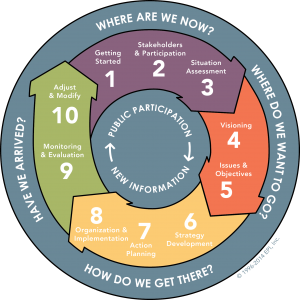We were approached by the Council for the Advancement of Native Development Officers (cando) to write a quarterly article on the strategic planning process for their newsletter – ‘N-Side’. cando is a great organization that provides support and capacity building for Economic Development Officers in First Nations communities.
We thought we’d republish the articles here on our blog as they come out (though, admittedly, they are a bit long for a blog post!). The articles follow the 10 step strategic planning process that we use in all our work, and each article will highlight 1-3 of the steps. We are happy to share this information and hope that it is useful for your planning processes. If you are going to use it in toolkits, guides, or other materials please give us credit.
——–

Getting Started with Strategic Planning
We all know the value of being strategic. Yet we often overlook a longer-term, strategic approach when it comes to economic development. Why? Because of limited resources and time, or a lack of organizational capacity or cooperation. Just keeping up with various proposals or “putting out fires” leads to reactive crisis planning.
Strategic planning is about making better decisions, getting ahead of the game, pursuing a common vision and leading rather than reacting. Good planning means your community and business enterprises make sense by making sure you are following your heart, listening to your gut and verifying with your head.
This is the start of a series of articles on both the value of strategic planning in economic development and how to best approach it. Each quarter, we’ll cover one or two of the ten planning stages in the strategic planning process – illustrating with Canadian case studies and examples how you can easily integrate a more strategic approach to your economic development process, and the benefits of doing so.We’ll address common reasons why communities don’t embark on strategic planning (such as conflict in the community, limited resources etc.), some of the consequences of doing or not doing strategic planning, and discuss ways that communities have overcome common obstacles.
The Strategic Planning Process
The method covered in these articles was developed by EcoPlan to help communities systematically and successfully embark in what is often seen as a big and confusing process of strategy development. It has been used in dozens of Canadian First Nations communities, and by numerous cities and communities around the world and is now been embraced by the United Nations as their approach to strategic planning for local economic development (UN-HABITAT).

Step 1: Getting Started
The first step is to just get started. This seems so simple; it is easy to overlook. But this is about getting past the inertia of doing the things you have always done and acknowledging that you are embarking on a new path. As they say, the definition of insanity is doing the same thing over and over but expecting different results. Part of doing good planning is to think about what you are going to do. Rather than skipping straight to the ‘answer’ (the later ‘action’ stages in a good approach), this step is about slowing down and making sure you ‘plan to plan’. This can make a huge difference to the success of a strategy.
1.1 Gain commitment and build trust
Get commitment from the community – Getting commitment for a plan requires a patient exchange of information. Rushing too quickly into a plan can cause it to fail before it even starts. You may need to ‘sell’ the idea to council members, elders, and other key stakeholders – communicating the benefits of strategic planning, while also acknowledging the challenges and difficulties. Building commitment and trust up front will lay the social foundation for future success and build trust with the rest of the community.
Case Study: Every community has past work to pull from, and expertise that can be tapped into. The ‘getting started’ phase is especially critical for understanding this and how it all fits into the process. The Blackfoot Crossing Historical Park (Siksika Nation – www.blackfootcrossing.ca) focused their economic development strategy on an Area Plan for their operation (one of Canada’s largest aboriginal tourism facilities!). Several meetings were required to create a clear picture of what past and current plans and strategies had been completed and how these could inform the process. This is about not “reinventing the wheel”, or starting from scratch with every new process. Disregarding previous work is one of the easiest ways to frustrate stakeholders and lose trust.
1.2 Form the core planning team
The role of the core planning team is essentially that of project managers – making sure that the project can move forward, avoid administrative delays, and that the right people are involved at the right times. The core planning team should involve those with related past experience and directly relevant skills (e.g., staff who’ve had significant involvement in related planning processes or ‘gatekeepers’ of information). The team will likely be comprised of a few key staff members. Bringing in a diverse stakeholder group from the community will happen at a later stage.
Make sure there is a committed leader, such as an Economic Development Officer (EDO), who can shepherd the strategy through the process and then champion the strategy once it is completed.
1.3 Determine where the ‘local’ is in Local Economic Development
Is it just the reserve or is it the traditional territory? Are there some key locations that have been identified as economic or commercial areas? Where do on-reserve and off-reserve members live? Clearly articulating where ‘local’ is will reduce scope creep later on, and highlight who you need to get on board as partners (other neighboring towns, for example).
1.4 Planning to plan
Set up the systems now to ensure a smooth planning process. Clearly agree to the roles of all participants, the timelines that you will stick to, and the methods of dispute resolution. A document like a Terms of Reference can be helpful in formalizing this. Anticipate future challenges and try to build systems to overcome them.
1.5 Define the LED planning question
Before you starting trying to figure out a solution, you need to understand the problem. Is it all about jobs and revenue? What about broader questions like culture and community? Should the question be focused: “What are the best opportunities to generate income?” or more broad: “How can economic development contribute to increased quality of life?”. Think about what triggered the process or inspired the need for change.
Having a clear concept of the central planning question is fundamental to any strategy. This will be used over and over again as you engage stakeholders and make tough choices around which actions to take are best and why. This is a great exercise for the newly formed core planning team to work on together. Keep in mind that the scope of the question needs to acknowledge the resources available for the work – is there enough time, money, energy to tackle one of those ‘big picture’ questions or should the strategy focus on something more specific.
The next article will build on this framework and look at Step 2: “Stakeholders & Engagement”.
William Trousdale is the lead author of: “Promoting Local Economic Development through Strategic Planning” by UN-HABITAT and EcoPlan International (contact him for a copy). He can be reached at william@ecoplan.ca. Colleen Hamilton is a planning analyst at EcoPlan. She can be reached at colleen@ecoplan.ca
